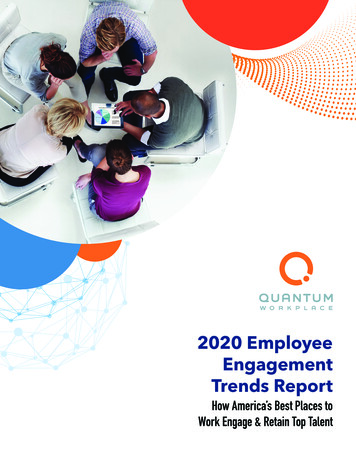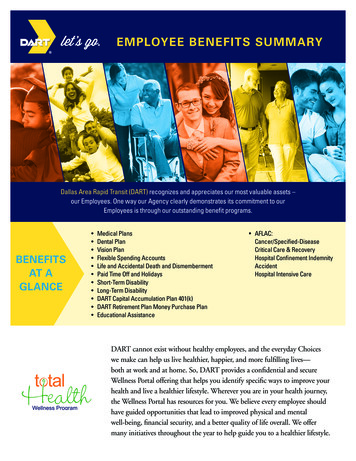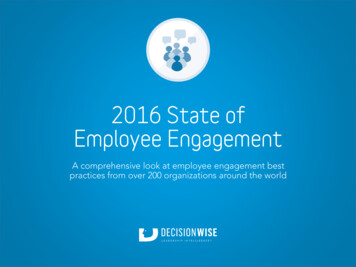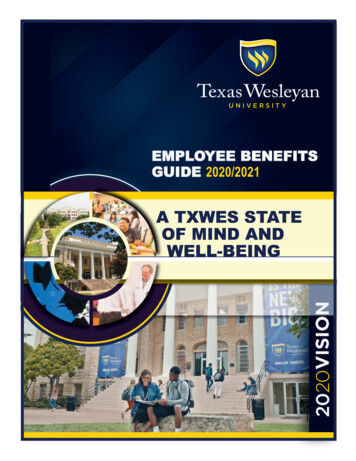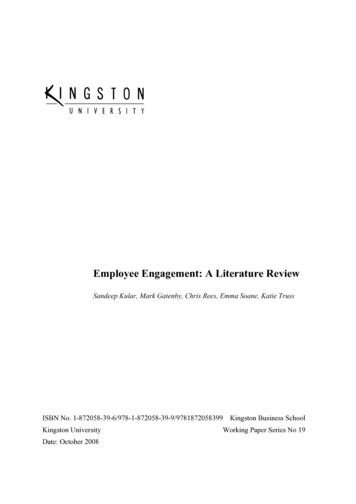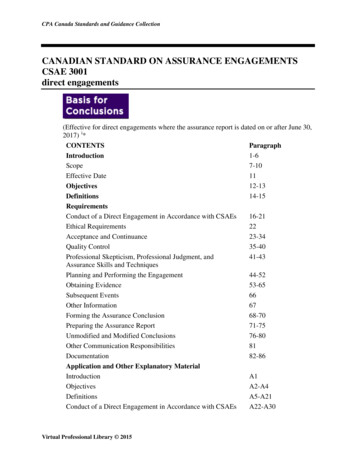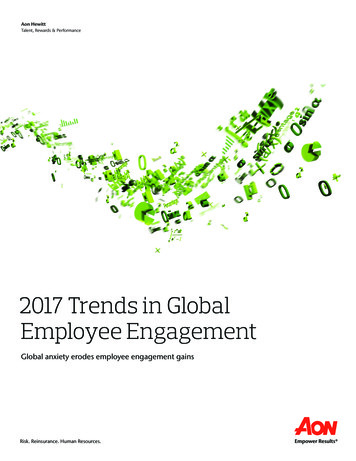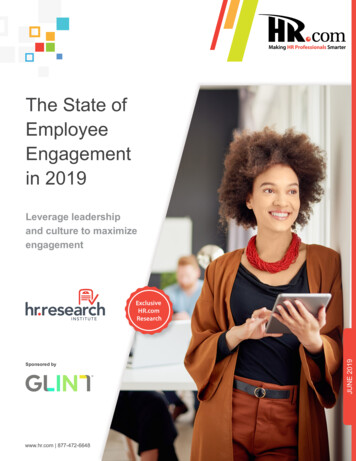
Transcription
The State ofEmployeeEngagementin 2019Leverage leadershipand culture to maximizeengagementSponsored bywww.hr.com 877-472-6648JUNE 2019ExclusiveHR.comResearch
The State of Employee Engagement in 2019Contents2Executive Summary3What Is Employee Engagement?6How Engaged Are Today’s Employees?8What Is the Impact of Engagement?11What Drives Engagement?14How Do Organizations Measure Engagement?17How Do Organizations Respond to Engagement Metrics Data?22How Can HR and Management Influence Discretionary Effort?24Key Takeaways34www.hr.com 877-472-6648copyright HR.com 2019
The State of Employee Engagement in 2019Executive SummaryEmployee engagement continues to be a primary organizational andhuman resources (HR) concern. As a result, many employers arecollecting, analyzing and acting on engagement data. To give HRprofessionals a point of reference, HR.com has conducted its secondannual study on the state of employee engagement.The main goals of this study were to: Gather information on engagement levels and current practice Gauge how effective engagement programs are Glean some insights on what has led to more successfulengagement programs3www.hr.com 877-472-6648copyright HR.com 2019About this SurveyThe survey, called “TheState of EmployeeEngagement”, ran inthe first quarter of 2019.There were responsesfrom 532 participants with414 responding to everyquestion.The majority of therespondents are HRprofessionals based inthe United States, andthe participants representa broad cross-section ofemployers by number ofemployees, ranging fromsmall businesses withunder 50 employees toenterprises with 20,000or more employees. Justover 40% of respondentsrepresent organizationswith 500 or moreemployees.
The State of Employee Engagement in 2019Here are some top-level findings from our reportMajor Finding One: Attaining high employee engagement levelscontinues to be a challenge. Only 44% strongly agree or agree that employees in theirorganization give discretionary effort, suggesting mostorganizations need substantial help in this area. Most participants believe that fewer than 70% of their employeesare engaged. This is particularly noticeable in mid-sizedorganizations, where only 14% report that more than 70% of theirworkforce is engaged.Major Finding Two: Leaders and immediate supervisors make thebiggest difference in engagement. More than anything else, leadership and the immediate supervisordrive employee engagement. Over 80% of HR professionals linkengagement to trust in leaders. Overall, only 29% of all HR professionals say their organizationshave leaders who prioritize engagement. Highly engaged organizations are three times as likely to havesenior leaders who prioritize employee engagement, whencompared to organizations with lower engagement. Respondents from highly engaged organizations are much morelikely to instill good leadership behaviors, compared to those whoare less engaged: 58% versus 33%. HR professionals are most likely to view immediate supervisorsand leaders as being responsible for engagement, and only33% suggest HR has a very high degree of responsibility forengagement.4www.hr.com 877-472-6648copyright HR.com 2019
The State of Employee Engagement in 2019Major Finding Three: Engagement might be improved through morefrequent measurement, better employee recognition, greater careergrowth opportunities, and more HR involvement. Highly engaged organizations are more likely than otherorganizations to measure engagement, and they are more likely tomeasure it more than once a year. Highly engaged organizations are far more likely to recognizeemployees for a job well done. While 71% of highly engagedorganizations recognize employees for a job well done, the sameis true for only 41% of less engaged organizations. Providing career growth opportunities is a major differentiatorbetween highly engaged organizations and others. Only 15% ofless engaged organizations provide career growth opportunitiesto a high or very high degree, compared to 44% of highlyengaged organizations. HR is more likely to be strongly involved in employee engagementinitiatives in highly engaged organizations. HR is highly or veryhighly involved in employee engagement in about three-quartersof highly engaged organizations, compared to about half in otherorganizations.Major Finding Four: Engagement is still widely viewed as beinglinked to overall company performance. Over 90% believe there is solid evidence linking engagementto performance, and they believe it has the strongest impact oncustomer service and productivity. Highly engaged organizations are more than twice as likely toreport being top financial performers in their industries.5www.hr.com 877-472-6648copyright HR.com 2019
The State of Employee Engagement in 2019What Is Employee Engagement?Finding: Over three-quarters of HR professionals agree thatemployee engagement is both an emotional commitment and awillingness to give one’s best at workWe were interested in understanding how HR practitioners defineengagement. In the study, participants were provided a number ofdefinitions to choose from. Each definition is commonly associated withengagement but is not necessarily an ideal definition of engagement. Forexample, 72% say that a valid definition of engagement is “an employee’slevel of satisfaction with his or her work situation.” Some engagementexperts would disagree that this is a valid definition, but the fact that a highnumber of respondents identify it demonstrates that many HR practitionershave an inclusive rather than exclusive view of engagement.Fully 86% of HR professionals say, however, that engagement can bedefined as “an employee’s willingness to give his or her best at work,” and80% say it is “an employee’s emotional commitment to the organizationand its objectives.” These tend to be more conventional definitions ofengagement, so it is heartening that they are so widely chosen.So, why would there be so much variation in how HR practitioners defineengagement? There are a variety of possible reasons for that: Professional associations, vendors and academic institutionsoften seek to differentiate themselves from others with their owninterpretations, and definitions change as the body of knowledge grows. Every organization has its own culture and language. Although managers tend to like short but precise definitions, humanmotivation and behavior are complex.6www.hr.com 877-472-6648copyright HR.com 2019
The State of Employee Engagement in 2019Survey Question: Which of the following do you consider validdefinitions of employee engagement? (Select all that apply)An employee's willingness togive his or her best at work86%An employee's emotionalcommitment to theorganization and its objectives80%An employee's level ofsatisfaction with his or herwork situation72%An employee's state when theirpersonal values and goals arealigned with the organization68%An employee'spositive impact onbusiness results65%An employee's degree ofhappiness while in theworkplace64%Other7%07www.hr.com 877-472-664820406080copyright HR.com 2019About twothirds of HRprofessionalssee engagementin terms of anemployee havinga positive impacton businessresults
The State of Employee Engagement in 2019How Engaged Are Today’s Employees?Finding: Only 44% agree or strongly agree that employees intheir organization give discretionary effortOur research explores HR professionals’ opinions on the current stateof employee engagement in their organizations. Based on the previousfinding, engagement is most widely viewed as occurring when an employeegives his or her best at work. This can also be called discretionary effort.In this study, we asked participants about the degree to which employeesput forward such effort. Only 10% strongly agree that their employees do,with another 34% agreeing. This indicates that most employers still faceemployee engagement challenges. On a more positive note, few (14%)went so far as to strongly disagree, disagree or somewhat disagree with thestatement that employees give discretionary effort.Survey statement: Employees in my organization give discretionaryeffort.Strongly agree10%Agree34%Somewhatagree35%Neither agreenor disagree7%SomewhatdisagreeDisagree3%Strongly disagree1%08Fewer than 5% ofHR professionalsdisagree orstrongly disagreethat theiremployees givediscretionaryeffort10%510www.hr.com 877-472-66481520253035copyright HR.com 2019
The State of Employee Engagement in 2019Finding: Small organizations are somewhatmore likely than large or mid-sized ones tohave employees who give discretionary effortNearly half of small organizations agree or stronglyagree that their employees give discretionary effort.Mid-sized organizations are least likely to haveemployees who give discretionary effort (39%).Survey statement: Employees in my organization give discretionaryeffort. (% agree or strongly agree)5048%44%39%4030Just two-fifthsof mid-sizedorganizationshave employeeswho givediscretionaryeffort20100 100 employees9www.hr.com 877-472-6648100-999employees1000 employeescopyright HR.com 2019
The State of Employee Engagement in 2019Finding: Small organizations are more likely than large ormid-sized ones to say that 70% or more of their employeesare engagedIn any organization, some employees will be more engaged than others.With this in mind, we asked what percentage of employees are engaged.It turns out HR professionals tend to believe that large swaths of theirorganizations are not engaged. Like the discretionary effort question, thisone also indicates that most employers could be doing much better in thearea of employee engagement.The results vary significantly by size of organization. Mid-sizedorganizations are most likely to have problems with engagement, as morethan one-quarter say fewer than 30% of their employees are engaged.Small organizations are most likely to have good results; over two-fifths saythat more than 70% of their employees are engaged.Survey Question: About what percentage of your organization’sworkforce do you believe is engaged?60%6056%5043% 43%4028%3024%2020%14%14%100 100 employees 30% engaged10100-999employees30-69% engagedwww.hr.com 877-472-66481000 employees70% or more engagedcopyright HR.com 2019Generallyspeaking, largerorganizationstend to enjoyhigher employeeengagement thanmid-sized ones
The State of Employee Engagement in 2019What Is the Impact of Engagement?Finding: Over 90% of HR professionals believe there is solidevidence linking engagement to performanceAs we’ve seen, many organizations are experiencing low employeeengagement rates. Is that because they do not believe engagementhas a significant impact on organizational performance? No. In fact, thisstudy indicates that there’s wide agreement that it has a high impacton performance. Over 20 years, a variety of studies have revealed thatthere’s a correlation between employee engagement and organizationalperformance. For many, the real question is whether engagement actuallydrives performance or is just associated with it (e.g., because similarorganizational factors drive both performance and engagement).Survey statement: Please rate the following statements astrue or false:There is solid evidence linkingengagement to performance93%There are reliable ways ofmeasuring employee engagement81%Performance drives engagementat least as much as engagementdrives performance64%Engagement is a means to anend, not an end unto itself64%It's possible to focus too much onemployee engagement as a goal52%The meaning of employeeengagement is vague36%Engagement and job satisfactionare basically the same20%011www.hr.com 877-472-664820406080100copyright HR.com 2019Most HRprofessionalsbelieve there arereliable waysof measuringengagement
The State of Employee Engagement in 2019Finding: Engagement has the biggest impact oncustomer serviceHR professionals tend to believe that engagement has a positiveimpact on a number of performance indicators. Customer serviceis the area most commonly identified as having a very high impact.If we add high and very high impact, then productivity is nearly asimpactful. Overall, HR professionals tend to believe that employeeengagement has a positive impact on a variety of issues.Survey Question: In your organization, to what degree do higher ratesof engagement have a positive impact on the following areas?41%Customer serviceProductivity31%Product quality32%43%Company brand34%39%21%Financial performance0Very high12www.hr.com hcopyright HR.com 2019Over 40% of HRprofessionalssay employeeengagement has avery high impacton customerservice
The State of Employee Engagement in 2019Finding: Most HR professionals (60%) feel employeeengagement should be at or near the top of their list of prioritiesThe emphasis HR typically places on engagement is backed by an honestbelief that it matters. Ninety-six percent feel engagement is crucial orimportant. HR leaders should check to see if their belief in the importanceof engagement is shared by management. If managers don’t believe in theimportance of engagement, then that will limit HR’s ability to improve it.Survey Question: Which of the following best describes the way youfeel about the subject of employee engagement? (select one)?It's crucial and should beat or near the top of ourlist of priorities60%It's important but it's justone of multiple factorsthat concern us36%It's moderately importantbut tends to be overhypedas a concept3%It's basically a scamperpetrated by consultantslooking for money1%It's way oversold and does notdeserve nearly as muchattention as it gets1%013www.hr.com 877-472-664810Only 5% of HRprofessionalssay employeeengagement hasbeen overhyped,oversold or is ascam2030405060copyright HR.com 2019
The State of Employee Engagement in 2019What Drives Engagement?Finding: More than anything else, leadership and immediatesupervisors drive employee engagementAround 80% of respondents believe engagement is highly linked to trustin leadership and the relationship with the immediate supervisor. However,the importance of these two factors should not overshadow the othercontributors such as a sense of purpose and organizational culture, both ofwhich are seen as highly linked to engagement by about three-quarters ofparticipants.Survey question: Which of the following factors are most highly linkedto employee engagement in your organization? (Select all that apply)81%Trust in leadersRelationship withimmediate supervisor79%A sense of purpose75%Organizational culture74%Belief in the organization69%Opportunities forcareer growth68%Enjoyment of work68%Relationship with colleagues67%Physical environmentof the workplace37%Sense of psychological safety35%Other5%014www.hr.com 877-472-664820406080100copyright HR.com 2019
The State of Employee Engagement in 2019Finding: HR professionals are most likely to view immediatesupervisors and leaders as being responsible for engagementAnother survey finding supports the notion that leaders and supervisorsbear most of the responsibility for improving employee engagement.What’s interesting is that top leaders bear about the same responsibilityas immediate supervisors, which challenges some of the conventionalwisdom in the area of engagement. Typically, managers say that employeesdo not leave jobs; they leave bosses. But that only scratches the surface.Employees need to feel not only that they have an environment wherethey can thrive but that their top leaders are taking the organization and itspeople in the right direction.HR professionals, however, view themselves as bearing less responsibilitythan leaders or employees themselves. Why? It’s probably because theyare not directly overseeing employees. On the other hand, HR professionalsare often in charge of conducting organizational climate surveys and runningprograms that influence engagement.It’s also worth noting that 70% of respondents say employees bear a highor very high degree of responsibility for engagement. This result points tothe need for a culture that emphasizes individual responsibility, and that inturn presumes a degree of empowerment. It also points to the importance ofhiring people who are likely to be engaged.15www.hr.com 877-472-6648copyright HR.com 2019
The State of Employee Engagement in 2019Survey Question: To what degree are the following groups responsiblefor employee engagement in your supervisorsTop leadershipVery high degree16www.hr.com 877-472-6648High degreecopyright HR.com 2019Just onethird of HRprofessionals sayHR departmentsbear a veryhigh degree ofresponsibilityfor employeeengagement
The State of Employee Engagement in 2019How Do Organizations Measure Engagement?Finding: Just over half of organizations measure engagementIf employee engagement is closely related to organizationalperformance, it follows that measuring it and finding ways to improveit should be a priority for a large majority of companies. In fact,however, only slightly more than half of respondents say theirorganizations measure engagement. On the other hand, if we focusin on large organizations, we find that most (72%) do.Why don’t more organizations measure engagement? Leadersof smaller organizations may feel that they are in touch with theiremployees and do not need surveys or other measurements to tellthem what they already know. Others may feel that engagement islow and do not want to call attention to it.Survey question: Does your organization measure employeeengagement?28%54%46%Almost threequarters of largeorganizationsmeasureengagement72%YesAll organizations17www.hr.com 877-472-6648NoOrganizations with 1,000 orMore Employeescopyright HR.com 2019
The State of Employee Engagement in 2019Finding: Conducting formal surveys is still the go-to method ofmeasuring engagementEmployee surveys have been with us since the 1930s, and they have a longhistory of both use and misuse. An annual survey can be a very useful andorganization-changing tool if used correctly, but they often try to capture toomuch data all at once. In reality, it can take months to analyze and formulatea response to the findings. By that time, the silence may have already leftemployees wondering if anybody cares.Organizations are experimenting with new ways to acquire more frequentand better-focused employee feedback. The use of more frequent surveysis receiving much attention, but organizations must find the right balance.They don’t want to cause survey fatigue. Trying to perfect this is an area ofexperimentation and innovation in some of today’s organizations.The 5% of organizations that answered “Other” use a variety ofmeasurement methods such as 360-degree assessments, stay interviews,and employee usage of internal social media.Survey Question: How does your organization measure employeeengagement? (select all that apply)73%Annual surveysExit interviews59%45%Retention rates42%One-on-ones with managers41%Performance management system36%Pulse surveys29%Customer satisfaction rates26%Employee productivity13%Product and service quality ratings4%Work done outside normal working hours5%Other01810www.hr.com 877-472-664820304050607080copyright HR.com 2019Almost 60% oforganizations useexit interviewsto measureengagement
The State of Employee Engagement in 2019Finding: Of those that measure engagement, most (83%) usemultiple methodsMany organizations use multiple measurement methods to assessengagement. In general, the more angles one has on the topic ofengagement, the more likely one is to have an accurate picture of thesituation. That said, we find the use of exit interviews troubling. Althoughthey can capture valuable data, they are difficult to administer in a waythat will make a departing employee comfortable with being truthful. Werecommend thorough validation before using them to gauge engagement.Some companies are beginning to experiment with continuously assessingengagement, sometimes by using an artificial intelligence (AI) to monitorsentiment in emails. Privacy is an obvious concern, and some vendorsoffering these AI tools indicate that they spend as much effort on protectingprivacy as they do on assessing engagement. This approach is clearlyexperimental but could lead to an easy and accurate way to continuouslymonitor some of the dimensions of engagement.Survey Question: How does your organization measure employeeengagement? (select all that apply)Number of Measurement Methods Used16 to 1017%19%Only 17% oforganizationsthat measureengagement relysolely on a singlemeasurementmethod2 to 564%19www.hr.com 877-472-6648copyright HR.com 2019
The State of Employee Engagement in 2019Finding: Of those organizations that measure engagement, wellover half do it annually or less frequentlyIn recent years, there have been more stories about how manyorganizations are moving toward more frequent employee engagementmeasurement methods. The theory behind this trend is that engagement isnot a constant that we can capture in a once-a-year snapshot. It fluctuatesfor every individual over time.Indeed, some organizations have moved in this direction. Ten percent of HRprofessionals say their organizations measure engagement continuously,and nearly a quarter of respondents measure it monthly, quarterly, or everysix months. However, this still means that well over half of respondentsmeasure it once a year or less often. In other words, the trend towardfrequent measurement of engagement is still not a mainstream one.Survey Question: How often is employee engagement formallymeasured? (select the one that best applies)Few organizations(10%) hly9%Quarterly13%Every six months47%Once a year12%Once every two or three years4%Only when we think it's relevant3%Other020www.hr.com 877-472-66481020304050copyright HR.com 2019
The State of Employee Engagement in 2019Finding: Almost a third of organizations have seenengagement improve by 1% to 10%One of the more positive findings in this study is that, on balance,organizations have been more likely to see engagement improve(38%) than decline (23%)—the remaining 39% felt engagementstayed the same. Of course, a less optimistic way of looking atthis data is that a majority of respondents (62%) believe thatengagement in their companies has either been stagnant ordeclined.Survey Question: Based on your metrics, how has the level ofemployee engagement changed over the last two years?39%403531%30A small slice oforganizations(7%) have seenengagementlevels move up bymore than 10%252017%15107%6%50Down bymore than10%21Downbetween 1%and 10%www.hr.com 877-472-6648About thesameUpbetween1% and10%Up bymorethan 10%copyright HR.com 2019
The State of Employee Engagement in 2019How Do Organizations Respond to EngagementMetrics Data?Finding: Most organizations (55%) share engagement resultswith the entire organizationSharing the results of employee surveys is essential to building trust in theorganization and its leaders. Whether you share feedback—and how youshare it—can have an effect on organizational culture.Just over half of the participants said their organizations communicateresults to the entire organization. Fewer, however, review results with entiredepartments or division teams. Since, as this study shows, engagementis largely driven by immediate supervisors, this may be something moreorganizations should consider. The trick is to communicate wisely andeffectively. Determining how best to do this is HR’s opportunity to influencetwo-way communication in the organization.Survey question: How do you share employee engagement data?(select all that apply)Communicate overallresults to the entireorganization55%Review of results atdepartment/division levelwith individual leaders55%Review of results withentire departmentsand/or division teams33%Communicate some butnot all of the data to theentire organization30%5%Other02210www.hr.com 877-472-66482030405060copyright HR.com 2019Only 33% of HRprofessionalssay theirorganizationsreview resultswith entiredepartments ordivision teams
The State of Employee Engagement in 2019Finding: Less engaged organizations are less likely to takespecific and forceful actions based on the engagement dataHighly engaged organizations are more likely to take specific actionsto boost engagement after engagement data are discussed within thecompany. Whereas 63% of highly engaged organizations take such actionsto a high or very high degree, the same is true for only 36% of engagedorganizations.Why? Perhaps there is a disconnect between HR and business leaders inless engaged organizations. If HR conducts an engagement survey andleaders do not act on it, then engagement may become worse than if thesurvey never happened.Most of the responsibility for action on engagement rests on senior leadersand immediate supervisors. Without communication and follow-up, theresult will be low trust in top leaders, frustrated supervisors, and disengagedemployees – and, as we have seen, lower organizational performance.Survey Question: After discussing engagement data, to what degreedoes your organization take specific actions to increase engagement?Highly engaged55%32%6%Less engaged36%02040%406023%80100Degree of ActionHigh/Very High23Moderatewww.hr.com 877-472-6648Low/VeryLowcopyright HR.com 2019It’s rare (6%) forhighly engagedorganizationsnot to act onengagement data
The State of Employee Engagement in 2019How Can HR and Management InfluenceDiscretionary Effort?As part of the analysis process, respondents were divided into two cohorts: Highly engaged organizations: These are organizations whereHR professionals agree or strongly agree that employees in theirorganization give discretionary effort, which is the level of effort aboveand beyond the minimum required to get the job done. Less engaged organizations: These are organizations whereHR professionals neither agree nor disagree, somewhat disagree,disagree or strongly disagree that employees in their organization givediscretionary effort, which is the level of effort above and beyond theminimum required to get the job done.Comparing these two cohorts provides insights into what actions mightinfluence discretionary effort.Finding: Highly engaged organizations are more than twice aslikely to be top financial performers in their industriesPerhaps before one asks how to improve discretionaryeffort, it is worth asking if discretionary effort matters. Thedata implies it does. The survey asked respondents abouthow they fared in terms of performance in their most recentfiscal years. Among highly engaged organizations, 19%report having far above average performance comparedto competitors in their industries. Among less engagedorganizations, the number was only 8%.Although this relationship between discretionary effortand financial performance may not be causative, it doeslend some support to the view of many HR professionalsthat there is a causal chain leading from engagement todiscretionary effort to financial performance.24www.hr.com 877-472-6648copyright HR.com 2019
The State of Employee Engagement in 2019Survey Statement: Please rate your organization’s performance in themost recent fiscal year compared to competitors in your industry.[% Far above average]Highly engagedorganizations19%Less engaged8%051015Only 8% oforganizations withless engagementhave “Far aboveaverage” financialperformance20Finding: Highly engaged organizations are more likely tomeasure engagementThe value of measuring engagement shows up in the fact that highlyengaged organizations are more likely to measure engagement than thosethat do not. This finding also reinforces the hypothesis that there is a causallink from measuring engagement to managing engagement to improveddiscretionary effort.Survey Question: Does your organization measure employeeengagement? (% “Yes”)6062%5041%40302010025Highly engagedorganizationswww.hr.com 877-472-6648Less engagedcopyright HR.com 2019Fewer than half oforganizations withless engagementmeasureengagement
The State of Employee Engagement in 2019Finding: Highly engaged organizations are more likely than otherorganizations to measure engagement more than once a yearNot only is measuring engagement associated with discretionary effort,measuring it often is associated as well. Highly engaged organizations aremore likely than other organizations to measure engagement more thanonce a year, and less likely to measure it less often than once a year.It appears that the greater the focus on engagement, the more likely theorganization is to get discretionary effort from employees. Over one-quarterof less engaged organizations measure engagement less often than once ayear or “as needed”.Survey Question: How often is employee engagement formallymeasured? (select the one that best applies)40%More thanonce a year34%30%44%Once a year47%39%On average,less engagedorganizationsmeasureengagement lessoften13%Less than once a yearor “as needed”16%27%010Highly engaged organizations26www.hr.com 877-472-664820All304050Less engagedcopyright HR.com 2019
The State of Employee Engagement in 2019Finding: Highly engaged organizations are far more likely torecognize employees for a job well doneHighly engaged organizations score considerably higher than less engagedorganizations on many different factors. Eye catching findings include thefact that most highly engaged organizations recognize employees for a jobwell done and provide meaningful work whereas fewer than half of lessengaged organizations do so. Another notable finding is that highly engagedorganizations are more than three times as likely to have leaders whoprioritize engagement.Since leaders almost certainly valu
annual study on the state of employee engagement. The main goals of this study were to: Gather information on engagement levels and current practice The majority of the Gauge how effective engagement programs are Glean some insights on what has led to more successful engagement programs About this Survey The survey, called "The


